Parenting Tips
Closing the Generation Gap: the Ultimate Guide to Understanding and Communicating With Parents From Different Eras
Step into the intricate world of understanding and connecting with parents from different eras, unraveling the secrets to bridging generational gaps and fostering stronger relationships.

{“statusCode”:401,”message”:”License key missing”}
Key Takeaways
- Acknowledge historical events shaping parents' values.
- Practice active listening to bridge communication gaps.
- Understand differing communication styles and preferences.
- Cultivate empathy to foster understanding across generations.
- Establish boundaries while appreciating diverse perspectives.
Characteristics of Parennials
Understanding the characteristics of Parennials is essential for effective communication and relationship-building with parents from this generation. Parennials exhibit a strong sense of parenting autonomy, preferring to make decisions independently. They often rely on the internet for parenting advice, turning to sources like Google and YouTube instead of traditional avenues.
This shift towards internet reliance highlights their openness to new methods and their assertiveness in setting boundaries. However, these changes can sometimes lead to conflicts and challenges within family dynamics. It's important to navigate these differences with empathy and understanding, bridging the generational gap for smoother interactions.
Challenges in Inter Generational Communication

Addressing intergenerational communication challenges requires acknowledging and addressing differences in values, experiences, and communication styles between parents and children. The Generation Gap, often amplified by technological advancements and shifting societal norms, can lead to misunderstandings and obstacles in communication.
Parents and children may have varying perspectives on parenting approaches, technology usage, and societal issues, creating barriers to effective dialogue. Historical events and cultural shifts further shape how parents and children interact and understand each other.
To bridge the generation gap, it's essential to approach communication with empathy, engage in active listening, and be willing to have open and honest conversations. By recognizing and respecting the differences in values and experiences between generations, both parents and children can work towards building stronger, more meaningful relationships.
It's through understanding and embracing these challenges that families can foster deeper connections and create a more harmonious intergenerational dynamic.
Advice for Grandparents

Hey there, grandparents!
As you navigate the role of grandparenting in modern times, remember the importance of bridging technology gaps with curiosity and a willingness to learn.
Sharing family heritage can create meaningful connections and provide a sense of identity and belonging for your grandchildren.
Embracing these aspects can enrich your relationship and create lasting bonds across generations.
Grandparenting in Modern Times
In today's rapidly changing parenting landscape, modern grandparents can enhance their role by staying informed and open-minded about the challenges and opportunities of grandparenting in the digital age. As senior citizens, you hold a wealth of wisdom and experience that can greatly enrich the lives of the younger generation.
Although online resources have become prevalent in seeking parenting advice, your unique insights and personal touch remain invaluable. By staying curious about your children's times and letting go of judgment, you can create a nurturing environment where communication thrives.
Asking for advice from your children not only reduces tensions but also fosters deeper understanding and connection. Embracing open-mindedness and showing overwhelming appreciation for your children can strengthen family bonds and bridge generational gaps.
Bridging Technology Gaps
To effectively bridge technology gaps with your grandchildren, consider embracing digital tools and platforms that they use for parenting guidance. In today's fast-paced world, technology impacts how parenting advice is sought and shared, creating generational differences in parenting approaches.
Here are some tips to help you explore this new landscape:
- Stay Curious: Explore parenting websites, apps, and social media platforms to understand the resources available to parents today.
- Ask for Guidance: Don't hesitate to ask your grandchildren for help understanding technology or grasping how they use it for parenting advice.
- Attend Workshops: Attend technology workshops or classes tailored for older adults to enhance your digital skills.
- Share Wisdom: While technology is valuable, your life experience and parenting wisdom are also invaluable. Find a balance between traditional advice and modern tools.
- Bond Over Tech: Use technology as a way to bond with your grandchildren. Play online games together or share interesting articles related to parenting.
Sharing Family Heritage
By embracing and sharing your family heritage, grandparents can pass down valuable wisdom and traditions to future generations. Your family heritage holds a wealth of stories, customs, and beliefs that can strengthen the bond between you, your children, and your grandchildren.
Generational differences may sometimes make it challenging to communicate effectively, but by opening up about your family heritage, you can create opportunities for understanding and connection. Embrace curiosity about your children's experiences and be willing to let go of any preconceived expectations to foster open communication within your family.
Seek support and self-awareness through counseling to navigate these generational differences with grace and enhance your relationships. Stay open-minded and ask thoughtful, open-ended questions to gain insights from your children and grandchildren, deepening your understanding and appreciation of each other.
Tips for Young Parents

As a young parent, finding balance between work and family life can be challenging, but remember to stay true to your priorities and set aside quality time for your loved ones.
Setting boundaries with technology is essential to guarantee meaningful connections with your children and promote healthy family dynamics.
Embrace these tips with an open heart, knowing that every effort you make in nurturing your family is valuable and significant.
Balancing Work and Family
When balancing work and family as a young parent, setting clear boundaries and prioritizing self-care are essential strategies to prevent burnout and manage stress effectively. It's important to remember that juggling these responsibilities can be challenging, but with the right approach, you can find a harmonious balance.
Here are some tips to help you navigate this demanding but rewarding journey:
- Create a flexible schedule: Adjust your work hours to accommodate family needs.
- Leverage technology: Utilize apps and tools for efficient time management.
- Build a support network: Seek help from family, friends, or support groups.
- Communicate openly: Talk to your employer about your family commitments.
- Practice mindfulness: Take time for yourself to recharge and stay present with your loved ones.
Setting Boundaries With Technology
To navigate the challenges of parenting in the digital age, young parents must establish clear boundaries with technology to maintain a healthy balance in their family life. Even though children live in a world where technology is ever-present, it's important to set limits to guarantee they develop essential life skills and maintain real connections with family and friends.
While it's tempting to rely on apps, Google, and YouTube for parenting advice, remember that traditional sources like grandparents offer valuable wisdom that shouldn't be overlooked. By setting boundaries with technology, you can create space for meaningful interactions, creativity, and quality time with your children.
Keep in mind that utilizing online resources should complement, not replace, hands-on parenting and face-to-face communication. Striking a balance between technology use and setting boundaries won't only benefit your family dynamics but also help you feel more confident and in control as a young parent in the digital era.
Impact of Technology on Parenting

As a parent maneuvering through these changes, here are some key ways technology is influencing modern parenting:
- Parennials, parents who are heavily reliant on technology, often turn to apps, Google, and YouTube for parenting advice, seeking quick solutions tailored to their child's needs.
- Grandparents, once primary sources of parenting wisdom, are now taking a back seat as technology provides instant access to a wealth of information, altering the traditional advice-giving dynamic.
- The accessibility of information through technology not only influences but also shapes parenting decisions, empowering parents to make informed choices.
- Technology enhances parenting autonomy and confidence among Parennials, offering support and guidance at their fingertips.
- The internet has revolutionized the way parents seek guidance, changing how they interact with parenting resources and fostering a community of shared experiences and knowledge.
Nurturing Family Relationships

Parenting in the digital age presents unique challenges, but fostering strong family relationships remains paramount for a thriving household. Building and nurturing family relationships require a deep understanding of the differences between generations. By actively listening, showing empathy, and engaging in open dialogue, you can bridge the generation gap and strengthen the bonds within your family.
Appreciating diverse perspectives, setting boundaries, and aiming for mutual understanding are key elements in nurturing family relationships. Each generation brings valuable experiences and wisdom to the table, which, when acknowledged, can lead to harmonious interactions and a sense of unity among family members.
Creating a supportive and inclusive environment through effective communication not only strengthens the familial bonds but also promotes a deeper connection and a shared sense of belonging. Remember, fostering strong family relationships takes effort and understanding, but the rewards of a close-knit and supportive family unit are immeasurable.
Strategies for Understanding Different Perspectives

When seeking to understand different perspectives from parents of varying eras, it's imperative to appreciate the significance of historical context in shaping their beliefs and values.
Show empathy towards their experiences, recognizing the impact of past events on their worldview.
Utilize active listening techniques to truly connect with their unique viewpoints and foster meaningful conversations that bridge generational gaps.
Historical Context Importance
Understanding the significance of historical context is essential for gaining insight into the diverse perspectives of parents from different eras. By delving into the historical events, societal norms, and cultural influences that have shaped the values and behaviors of parents over time, you can begin to appreciate the unique lens through which each generation views the world.
To help you navigate this journey of understanding, consider the following points:
- Historical events have a profound impact on shaping parental perspectives.
- Societal norms play an essential role in influencing parenting styles and beliefs.
- Cultural influences contribute to the values and behaviors passed down through generations.
- Exploring historical context can provide valuable insights into the challenges and experiences faced by parents from diverse eras.
- Understanding the historical backdrop allows you to empathize with the parenting styles and values of parents from different generations.
Empathy Towards Experiences
To foster empathy towards experiences and understand different perspectives, actively engaging in open-minded listening is essential. By truly listening to your parents from different eras, you can gain a deeper understanding of the challenges they faced and the values they hold dear.
Acknowledging the historical influences that shaped their perspectives allows you to appreciate the unique experiences that have shaped their lives.
Empathy towards experiences requires recognizing the impact of cultural norms and societal changes on their beliefs and behaviors. By taking the time to understand the generational challenges they encountered, you can bridge communication gaps and strengthen your relationship with them.
Active Listening Techniques
Engage in active listening techniques to better understand different perspectives and enhance communication with parents from different eras. Active listening involves more than just hearing; it requires your full attention, understanding, and appropriate responses to truly connect with the speaker.
Here are some strategies to help you become a better active listener:
- Focus on the Speaker: Dedicate your attention solely to the speaker without any distractions to show genuine interest in their perspective.
- Practice Reflective Listening: Repeat or paraphrase what the speaker said to make sure you grasp their message accurately, fostering a deeper connection.
- Utilize Nonverbal Cues: Use eye contact, nodding, and mirroring the speaker's emotions to convey empathy and understanding nonverbally.
- Build Trust and Strengthen Relationships: Active listening helps in building trust, strengthening relationships, and resolving conflicts effectively.
- Enhance Communication Skills: By actively listening, you can bridge the generation gap and communicate more effectively with parents from different eras.
Importance of Empathy in Communication

An essential aspect of effective communication with parents from different eras is recognizing the significance of empathy. Empathy goes beyond just hearing words; it involves truly understanding and sharing the emotions and experiences of your parents. By stepping into their shoes, you can grasp their viewpoints and connect on a deeper level. This emotional connection is the foundation of trust and strong relationships that can overcome any generational gaps that may exist between you.
| Importance of Empathy in Communication |
|---|
| Builds trust |
| Fosters better relationships |
| Bridges generational gaps |
| Acknowledges emotions |
| Overcomes misunderstandings |
Building Strong Connections

Understanding generational differences can greatly enhance your ability to build strong connections with parents from different eras. Effective communication strategies are key in bridging the gap with parents. Acknowledging and respecting their unique perspectives and experiences can deepen your relationships.
By sharing common interests and engaging in open discussions, you can foster understanding and closeness across generations. Cultivating empathy and patience is essential for creating meaningful and fulfilling connections with parents from different eras.
Remember, building strong connections takes effort and understanding from both sides. It's about listening with an open heart, being willing to learn from each other, and cherishing the bond that transcends age differences.
Embrace the opportunity to connect on a deeper level, knowing that the richness of these relationships lies in the willingness to bridge the gap with love and empathy.
Sensitivity in Inter Generational Relationships

To navigate intergenerational relationships effectively, it's essential to demonstrate sensitivity towards the diverse perspectives and experiences of parents from different eras. Understanding and respecting the impact of historical events, cultural norms, and technological advancements on parental behavior and communication styles is vital.
By actively listening, showing empathy, and being open to learning from the wisdom of parents across generations, you can nurture harmonious relationships. It's important to recognize potential differences in values, beliefs, and communication preferences to build positive connections.
Sensitivity fosters mutual understanding, appreciation, and effective communication, bridging the gap between parents and children from different eras. Embracing sensitivity in intergenerational relationships not only brings you closer to your parents but also enriches your own perspective and deepens your bond with them.
Frequently Asked Questions
How to Deal With the Generation Gap Between You and Your Parents?
Dealing with the generation gap between you and your parents involves understanding their unique communication styles and values. Open, respectful dialogue is key to bridging this gap and fostering mutual understanding.
Acknowledge the influence of historical events, cultural norms, and technological advancements on your generational differences. Finding common ground and shared experiences can help strengthen your relationship.
Approach conflicts with empathy, patience, and active listening to build a deeper bond across generations.
How Do You Close the Gap Between Generations?
To close the gap between generations, start by listening actively to your parents' stories and experiences. Show empathy towards their perspectives shaped by different eras.
Understanding their values in the context of historical events can build bridges between your worlds. Engage in open dialogues with respect and appreciation for their journey.
Embrace the richness of diverse viewpoints within your family, fostering harmony through connection and mutual understanding.
How Do You Communicate With Generation Gap?
To communicate effectively across the generation gap, it's essential to approach conversations with patience, empathy, and an open mind.
Active listening, where you truly hear and understand their perspective, is key. Show respect for their experiences and values, even if they differ from your own.
How Does the Generation Gap Affect Children's Relationships With Parents?
The generation gap can strain children's relationships with parents by causing misunderstandings and conflicts. Different values, beliefs, and communication styles can create tension.
Technology and societal changes widen this gap, leading to challenges in connecting with parents. Varied perspectives on parenting, discipline, and norms add complexity.
Understanding these differences and fostering open communication are crucial for bridging this gap and building stronger parent-child relationships.
Conclusion
In closing, remember that understanding and communication are key in bridging the generation gap with your parents. By embracing empathy, patience, and a willingness to learn from each other, you can build strong connections that will last a lifetime.
So, take a moment to listen, share, and connect with your parents – you may be surprised by the wisdom and insight they have to offer.
Let's work together to close the gap and strengthen our relationships across generations.
Parenting Tips
Unleash Your Public Speaking Potential With Confidence
Dive into mastering public speaking with confidence by learning essential techniques to captivate your audience and overcome stage fright.

Boost your public speaking skills by nailing the basics. Know your audience and design a clear speech layout. Tackle stage fright with deep breaths and expressive body language. Handle Q&A sessions calmly and confidently. Use visual aids to make your point stronger. These tips will unlock your public speaking potential and skyrocket your confidence.
Key Takeaways
- Practice speaking in front of a mirror multiple times for confidence.
- Utilize deep breathing and visualization techniques to overcome stage fright.
- Tailor your speech to connect with the audience on a personal level.
- Embrace non-verbal communication through eye contact and confident body language.
- Use clear speech structure with a compelling opening and strong conclusion.
Preparation for Public Speaking
Preparing meticulously for public speaking is essential for delivering a successful and impactful speech. Researching audience demographics, interests, and knowledge levels is vital. Understanding the importance of public speaking for communication skills, confidence, career growth, leadership, and effective idea conveyance is fundamental.
Practice speaking in front of a mirror and rehearse multiple times to build confidence. Creating a clear speech structure and tailoring content to connect on a personal level are key components. By focusing on these preparation steps, speakers can enhance their delivery and captivate their audience effectively.
Mastering Speech Structure
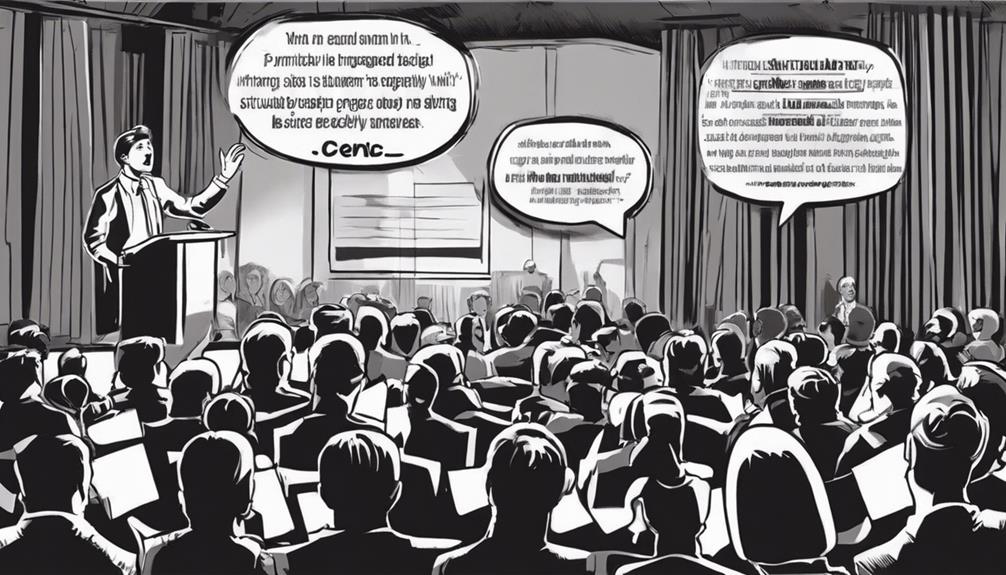
To excel in public speaking, mastering the structure of your speech is paramount for engaging and effectively conveying your message to the audience.
Begin with a compelling opening to grab attention, followed by a clear introduction of the main points. Organize these points logically, supporting them with relevant examples or stories. Guarantee a smooth shift between sections to maintain coherence.
End with a strong conclusion that reinforces your key message and leaves a lasting impact. Practice your speech multiple times to familiarize yourself with the content, tone, pace, and body language.
Embrace non-verbal communication through eye contact, confident posture, and effective gestures. Utilize visual aids sparingly to enhance, not overpower, your message.
Overcoming Stage Fright

Conquering stage fright is an essential aspect of delivering a successful public speech, requiring mastery of self-confidence and effective coping strategies. When facing stage fright, deep breathing exercises and visualization techniques can help calm nerves. It is important to focus on the message, engage the audience, and start with a strong opening. Enhancing presence through confident body language, eye contact, gestures, and voice modulation can also alleviate anxiety. Avoiding fidgeting, speaking clearly, varying pitch, and controlling the pace of speech are key strategies to overcome stage fright. Here is a table summarizing key points:
| Stage Fright Coping Strategies | Examples | Effectiveness |
|---|---|---|
| Deep breathing exercises | Diaphragmatic breathing | Calms nerves |
| Visualization techniques | Imagining a successful speech | Boosts confidence |
| Focus on the message | Engage with the audience | Reduces anxiety |
| Confident body language | Maintaining good posture | Enhances presence |
| Voice modulation | Varying pitch and pace | Controls nervousness |
Handling Q&A Sessions

When moving from delivering a speech to interacting with the audience in a Q&A session, it is important to maintain composure and actively listen to questions being posed.
During Q&A sessions, follow these key strategies:
- Listen Carefully: Pay close attention to each question to provide relevant responses.
- Remain Calm: Stay composed and confident, even if faced with challenging or unexpected queries.
- Engage with Gratitude: Thank the audience for their questions and show appreciation for their participation.
Visual Aids and Message Reinforcement
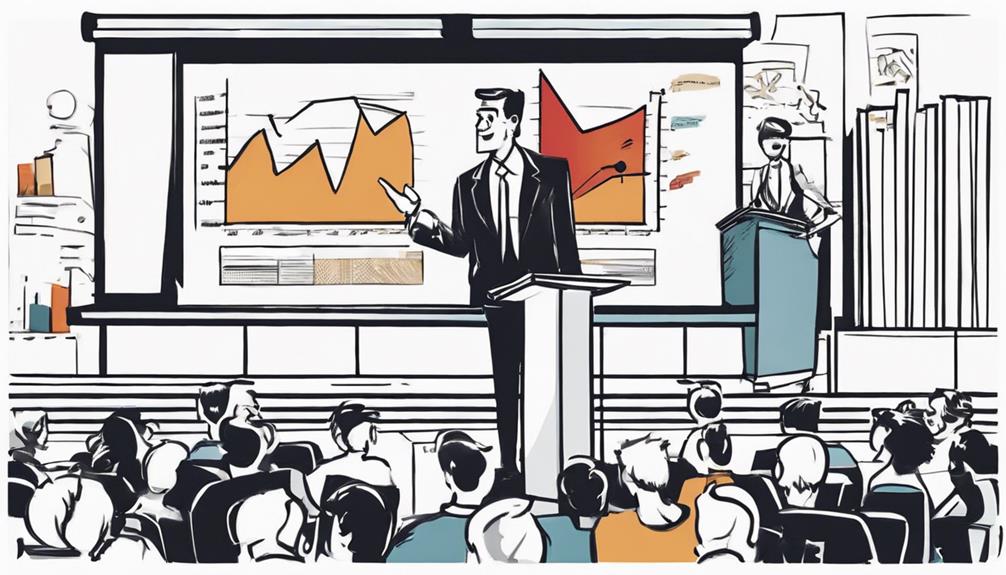
Utilizing visually appealing aids is pivotal in reinforcing the message delivered during a public speech. Visual aids, such as slides, props, or multimedia presentations, serve to enhance audience understanding and retention of key points.
When incorporating visual elements, it is essential to keep them simple, clear, and complementary to the spoken content. Overloading the audience with visuals can distract from the message, so it's essential to strike a balance that guarantees a memorable speech delivery.
Effective non-verbal cues, gestures, and body language can further reinforce the intended message, creating a cohesive and impactful presentation. Establishing a strong presence on stage through confident posture, eye contact, and appropriate hand movements enhances the overall delivery of the speech.
Frequently Asked Questions
How Can I Effectively Engage a Diverse Audience?
To effectively engage a diverse audience, tailor your content to resonate with their backgrounds and interests. Utilize engaging storytelling, interactive elements, and inclusive language. Encourage participation, listen actively, and adjust your delivery to guarantee everyone feels acknowledged and valued.
What Are Some Strategies to Handle Technical Difficulties During a Presentation?
In the field of public speaking, handling technical glitches demands a calm demeanor, quick thinking, and preparedness. Confirm backup plans for equipment failures, practice with the technology, and maintain composure to troubleshoot effectively.
How Do I Maintain Audience Interest Throughout a Longer Speech?
To maintain audience interest throughout a longer speech, engage them with compelling stories, interactive elements, and relevant examples. Vary your tone, pace, and delivery to keep them attentive. Use visuals sparingly to supplement key points and enhance message retention.
What Are Some Tips for Incorporating Humor Into a Serious Speech?
Incorporate humor strategically by using relevant anecdotes, witty remarks, or light-hearted observations to break tension, engage the audience, and make complex topics more digestible. Balance humor with professionalism to maintain credibility and impact.
How Can I Address Audience Skepticism or Resistance During a Presentation?
To address audience skepticism or resistance during a presentation, employ strategic storytelling, provide credible evidence, acknowledge opposing viewpoints respectfully, and engage in active listening. Build trust by establishing common ground and demonstrating empathy towards differing perspectives for a more receptive audience.
Conclusion
To sum up, mastering the art of public speaking requires careful preparation, confident delivery, and effective message reinforcement. By honing speech structure, overcoming stage fright, and utilizing visual aids strategically, individuals can unlock their full potential as speakers.
Embracing these practices will not only enhance communication skills but also leave a lasting impact on the audience. With dedication and practice, anyone can become a compelling and confident public speaker.
Parenting Tips
Youth Drive Eco-Friendly Revolution Against Plastics
Unleash the power of youth in the fight against plastic pollution by discovering their innovative eco-friendly initiatives and impactful contributions.
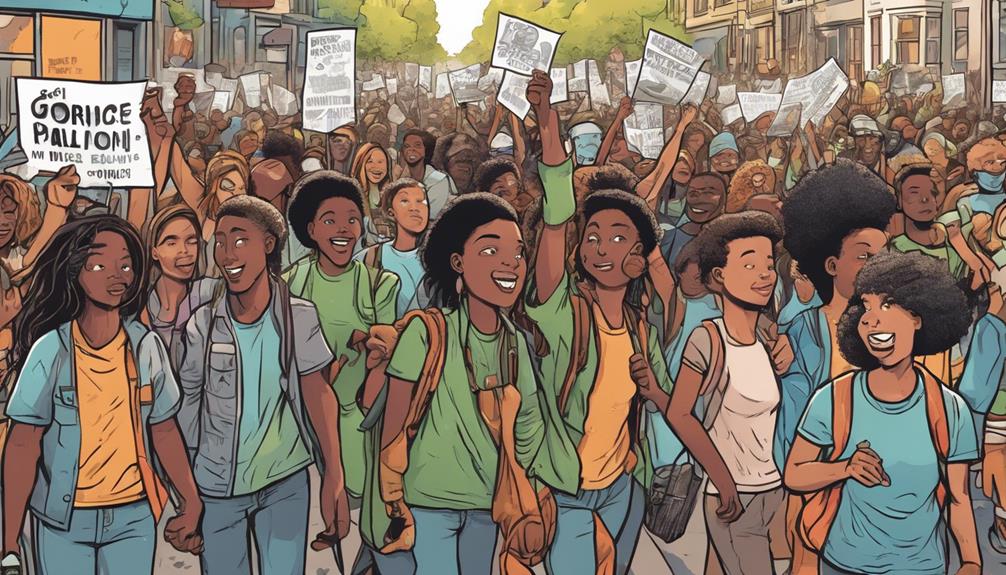
The youth are at the forefront of combating single-use plastics, advocating for sustainable alternatives to tackle the pressing issue of plastic pollution. With 14 million tons of plastic entering the oceans annually, urgent action is essential. Despite challenges like lack of awareness and cheap plastic production, promoting eco-friendly practices, such as using reusable items, and supporting local businesses with green initiatives can make a significant impact. Engaging students in environmental efforts not only instills responsibility but also empowers them to lead the eco-friendly revolution. By educating and involving the younger generation, a cleaner and healthier environment can be achieved.
Key Takeaways
- Educate students on plastic alternatives and eco-friendly practices.
- Empower students to advocate for policy changes promoting sustainable initiatives.
- Encourage students to lead by example in reducing plastic consumption.
- Implement green practices within educational settings to inspire eco-friendly habits.
- Foster a sense of responsibility in students to drive the eco-friendly revolution against plastics.
Impact of Single-Use Plastics
Annually, a staggering 14 million tons of plastic find their way into Earth's oceans, highlighting the detrimental impact of single-use plastics on the environment.
Despite campaigns like Keep Britain Tidy, the persistence of single-use plastics poses a significant threat to marine ecosystems. Organizations are actively working towards replacing these plastics with sustainable alternatives to mitigate the environmental damage caused.
The youth, in particular, are affected by the toxic repercussions of plastic pollution. As plastic waste continues to accumulate in oceans, urgent action is required to address this global issue.
It is essential to raise awareness about the consequences of single-use plastics and promote eco-friendly practices to combat this growing environmental challenge.
Challenges in Reducing Plastic Waste

Despite efforts to raise awareness and promote eco-friendly practices, reducing plastic waste globally presents numerous challenges that hinder progress towards a sustainable future. One major challenge is the lack of awareness on plastic waste and its environmental impact.
Disparity in reducing single-use plastics globally also poses a significant obstacle. The cheap production of plastics makes it challenging to phase them out in favor of more sustainable options.
Additionally, the need for widespread eco-friendly practices is essential but often not implemented on a large scale. Education on the effects of pollution caused by plastics is lacking, further complicating efforts to reduce plastic waste effectively. These challenges highlight the complex nature of addressing plastic waste on a global scale.
Promoting Sustainable Practices

One significant approach to addressing the challenges in reducing plastic waste is by promoting sustainable practices that prioritize eco-friendly alternatives and responsible waste management.
By advocating for the use of eco-friendly alternatives to single-use plastics, such as reusable bags and water bottles, individuals can greatly reduce their plastic consumption.
Supporting local businesses that implement eco-friendly initiatives and encouraging schools to adopt sustainable practices are also effective ways to promote a more environmentally conscious lifestyle.
Additionally, promoting important waste management, such as proper recycling and disposal of plastics, plays a vital role in minimizing the environmental impact of plastic waste.
Engaging Students in Environmental Initiatives
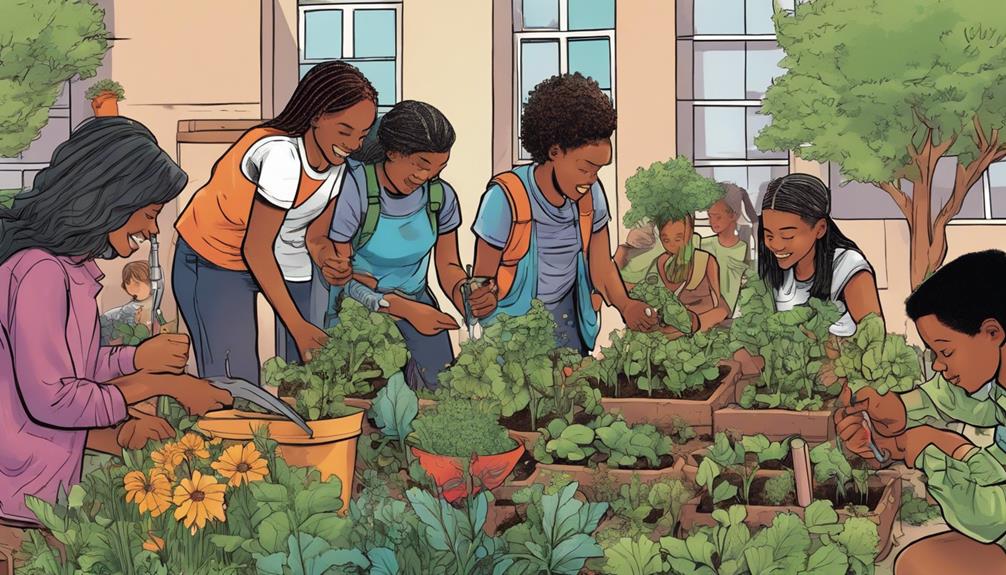
Involving students in environmental initiatives is crucial for cultivating a culture of sustainability and fostering a sense of responsibility towards the environment.
By educating students on plastic alternatives and empowering them to demand eco-friendly products, schools can play a significant role in shaping future environmental leaders.
Implementing green practices within educational settings, such as reducing printing waste and promoting sustainable alternatives, helps students understand the importance of environmental conservation.
Through these initiatives, students can learn the value of responsible waste management and contribute to minimizing their ecological footprint.
Leading Eco-Friendly Revolution
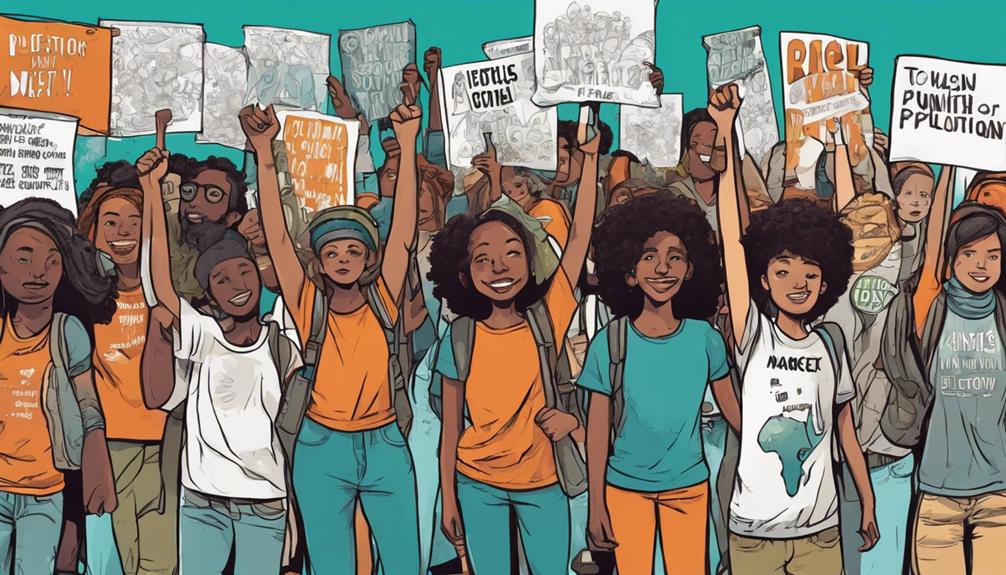
Educating and empowering students on eco-friendly practices is fundamental in leading the eco-friendly revolution towards sustainable living. By instilling a sense of responsibility and understanding the impact of their actions, students can become catalysts for change. Here is a table showcasing key strategies to lead the eco-friendly revolution:
| Strategies | Description |
|---|---|
| Implement Green Practices | Schools can adopt sustainable practices like recycling programs and reducing plastic waste. |
| Advocate for Policy Changes | Students can push for policy changes at school and community levels to promote eco-friendly practices. |
| Lead by Example | Embracing sustainable practices, using reusable items, and volunteering to make a positive impact. |
| Educate and Empower | Educating peers, sharing facts, and demanding eco-friendly products to create a culture of environmental responsibility. |
Frequently Asked Questions
How Can Youth Effectively Influence Companies to Prioritize Recyclability?
Youth can effectively influence companies to prioritize recyclability by engaging in advocacy efforts, leveraging social media platforms to raise awareness, collaborating with environmental organizations, and participating in sustainable initiatives to showcase the demand for eco-friendly practices.
What Innovative Ways Can Schools Implement to Reduce Printing Waste?
To reduce printing waste, schools can implement digital platforms for assignments, utilize double-sided printing, encourage electronic submissions, promote paperless communication, establish printing quotas for students, and educate on eco-friendly practices. These innovative methods foster sustainability and cost-efficiency.
Are There Specific Strategies to Empower Students to Demand Eco-Friendly Products?
To empower students to demand eco-friendly products, schools can educate on sustainable options, encourage activism for environmentally responsible choices, collaborate with local businesses promoting green initiatives, and integrate eco-friendly practices into the curriculum.
How Can Local Businesses Be Supported in Implementing Eco-Friendly Initiatives?
Local businesses can be supported in implementing eco-friendly initiatives by providing financial incentives, offering training on sustainable practices, connecting them with eco-conscious suppliers, and promoting their efforts through community partnerships. Collaboration is key for lasting impact.
What Are the Key Steps to Fostering a Culture of Environmental Responsibility in Schools?
Fostering a culture of environmental responsibility in schools involves educating students on eco-friendly practices, empowering them to demand sustainable solutions, implementing green initiatives, reducing waste, and advocating for policy changes at school and community levels.
Conclusion
To sum up, crucially, the youth-led eco-friendly revolution against plastics showcases the power of collective action in combating environmental threats. By promoting sustainable practices, engaging students in initiatives, and leading the charge for change, these young activists are driving a dynamic shift towards a cleaner, greener future.
Their dedication and determination to tackle the challenges posed by plastic waste serve as a shining example of environmental stewardship and responsibility. Let us all join in this essential mission to protect our planet for generations to come.
Parenting Tips
Unleashing Potential: Bruce Lee's Inspirational Lessons
Discover the transformative power of Bruce Lee's teachings and unlock your potential through philosophy, physical training, and strategic thinking.

Bruce Lee’s life lessons push for growth through **philosophy**, exercise, and smart thinking. Conquering challenges, using strengths in conflicts, and building a good work ethic by training the whole body are key. Staying calm and thinking strategically matter. There are efforts to keep his legacy alive with historic spots and filming sites. You can join in through online groups and social media. As a long-time teacher, the author shares cool ideas on growing personally and learning. Check out related info and chat with others for even more knowledge. **Bruce Lee’s lessons inspire.**
Key Takeaways
- Philosophy of hard work and continuous improvement for personal growth.
- Leveraging strength for conflict resolution and strategic responses.
- Training every part of the body for a strong work ethic.
- Preserving Bruce Lee's legacy through historic locations and landmarks.
- Engage with online community for educational insights and inspiration.
Influence on Personal Growth
Bruce Lee's philosophy of physical training and hard work propelled me to conquer personal challenges and embrace a mindset of continuous improvement. His belief in leveraging the enemy's strength to handle conflicts calmly resonated deeply within me.
The emphasis he placed on training every part of the body inspired a strong work ethic that I aim to embody daily. One of the key takeaways from Lee was the ability to remain composed in the face of provocation and respond strategically.
Witnessing how he lived out his teachings emphasized the importance of leading by example, a principle I now hold close to my heart. Bruce Lee's influence continues to shape my approach to personal growth and self-improvement.
Legacy Preservation Efforts

Efforts are underway to secure and preserve historic locations in Pak Chong related to Bruce Lee's legacy. The Big Boss house, an important filming spot, has remained largely unchanged since 1971.
Plans for the refurbishment of Wat Siri Samphan, the temple at the filming site, are in progress. Collaborative initiatives are working diligently to maintain iconic structures for future generations to appreciate.
These preservation endeavors aim to honor Bruce Lee's profound impact on martial arts and cinema. By safeguarding these filming sites and historical landmarks, the legacy of Bruce Lee can be protected and celebrated for years to come.
The commitment to preserving these significant locations showcases the enduring influence and importance of Bruce Lee's contributions to the world of entertainment and martial arts.
Community Engagement Opportunities

Engage with a network of like-minded individuals passionate about preserving historical landmarks by joining the Richard Rogers online community for daily updates on educational content.
Stay connected by following on Twitter and liking the Facebook page.
Engage with like-minded individuals interested in education and Bruce Lee's legacy.
Connect with a network of individuals passionate about preserving historical landmarks.
Opportunities to contribute to initiatives preserving Bruce Lee's impact are available.
Author Background and Expertise

My background includes being a high school science and mathematics teacher with a BSc (Hons) in Molecular Biology from Bangor University. I also hold a PGCE in Secondary Science Education and a Certificate in Mathematics.
Additionally, I'm an award-winning author of 'The Quick Guide to Classroom Management' and have experience in blogging on topics related to education, science, and mathematics teaching. With a strong foundation in both scientific knowledge and pedagogical skills, I aim to provide valuable insights and educational content to readers.
My expertise lies in creating engaging and informative material that resonates with individuals interested in personal growth, education, and the legacy of inspirational figures like Bruce Lee.
Related Content and Interaction

Exploring various articles by Richard James Rogers provides valuable insights on education, personal growth, and the legacy of inspirational figures like Bruce Lee. When investigating related content and interaction, readers can expect the following:
- Read more articles by Richard James Rogers covering education and personal growth topics.
- Gain deeper insights into Bruce Lee, Pak Chong, and 'The Big Boss' movie.
Engage with the author through comments, shares, and likes on blog posts.
- Stay updated on new publications and educational resources.
These interactive opportunities allow readers to explore further into the teachings of Bruce Lee and the impact he's had on personal growth and education.
Frequently Asked Questions
How Can I Incorporate Bruce Lee's Teachings Into My Daily Life?
I incorporate Bruce Lee's teachings into my daily life by applying his philosophy of hard work and using challenges as opportunities for growth. I remain calm, focus on training every aspect, and lead by example.
What Other Historic Landmarks Related to Bruce Lee Are Being Preserved?
Other historic landmarks related to Bruce Lee being preserved include the Big Boss house and Wat Siri Samphan in Pak Chong. Collaborative efforts are underway to maintain these iconic structures and secure his legacy for future generations.
What Types of Educational Content Can I Expect in the Online Community?
In the online community, expect a diverse range of educational content covering topics like personal growth, Bruce Lee's philosophy, historical preservation efforts, and community engagement opportunities. Stay informed, inspired, and connected with like-minded individuals.
Can Richard James Rogers Provide Personalized Teaching Advice?
Yes, I can provide personalized teaching advice. Drawing from my experience as a high school science and mathematics teacher, I offer tailored guidance to support educators in enhancing their classroom management and instructional strategies.
Are There Opportunities for Readers to Contribute Their Own Stories or Insights?
Yes, there are opportunities for readers to contribute their own stories or insights. I encourage sharing personal experiences and insights to foster a collaborative learning environment and enrich our community with diverse perspectives.
Conclusion
To sum up, Bruce Lee's timeless teachings on unlocking potential serve as a beacon of inspiration for individuals seeking personal growth and empowerment.
As the legendary martial artist once said, 'Be like water.' This adage encapsulates the essence of adaptability and resilience, urging us to flow and evolve with life's challenges.
Through embracing Bruce Lee's philosophy, we can tap into our inner strength, overcome obstacles, and aim for greatness in all aspects of life.
-

 Parenting Styles1 week ago
Parenting Styles1 week agoWorst Parenting Style: Impact on Child Development
-

 Parenting Styles1 week ago
Parenting Styles1 week ago2023 Indiana Parenting Time Guidelines Update
-

 Vetted7 days ago
Vetted7 days ago15 Best Books on Step Parenting Every Blended Family Needs to Read
-

 Parenting Tips6 days ago
Parenting Tips6 days agoUnequal Responsibilities: When One Parent Does All the Parenting
-

 Parenting Tips1 week ago
Parenting Tips1 week agoFostering Love: How Much Do You Get Paid for Foster Parenting?
-

 Vetted6 days ago
Vetted6 days ago15 Best Parenting Books of All Time Every Parent Should Read
-

 Vetted18 hours ago
Vetted18 hours ago15 Best Co-Parenting Books Every Parent Should Read for Successful Co-Parenting
-

 Vetted6 days ago
Vetted6 days ago15 Best Books for Gentle Parenting Every Parent Should Read

















